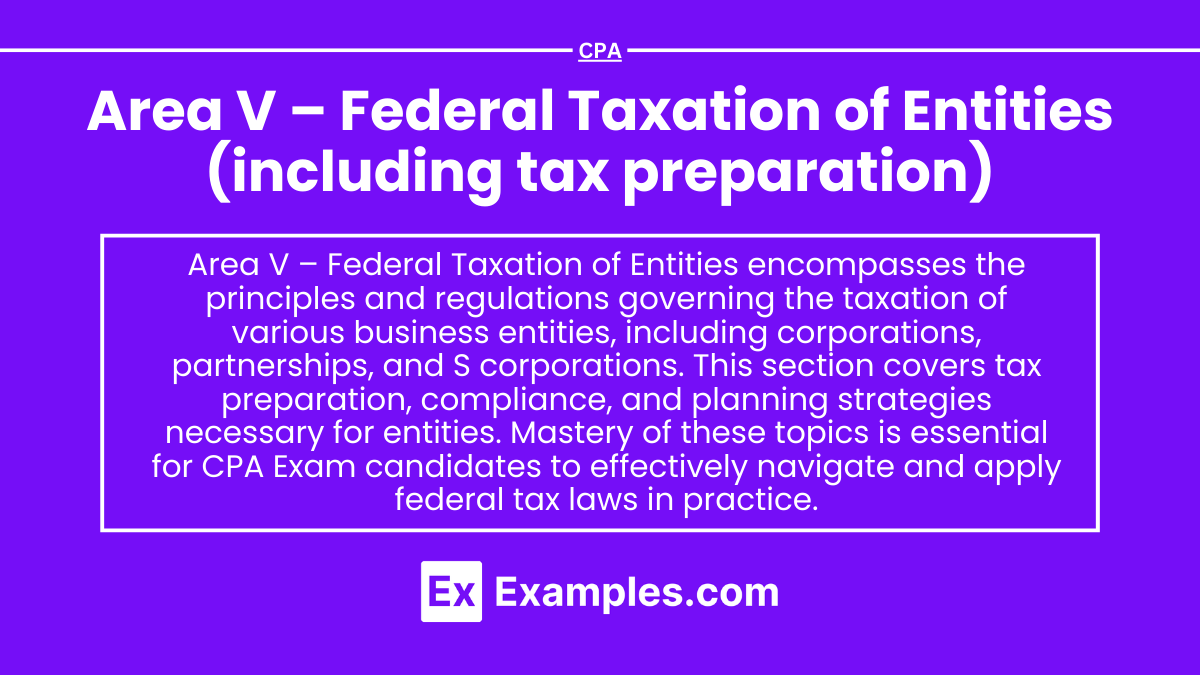Federal taxation of entities is fundamental to business operations, impacting decision-making and compliance. On the CPA Exam, you’ll explore the tax treatment of various entities, including corporations, partnerships, S corporations, and estates. Understanding tax preparation, deductions, credits, and filing requirements is crucial, as these topics are key to mastering the Regulation (REG) section of the exam. Proficiency in entity taxation ensures you can navigate tax laws effectively, ensuring proper compliance and advising clients on strategies for tax optimization.
Learning Objectives
In studying “Area V – Federal Taxation of Entities (including tax preparation)” for the CPA Exam, you should learn to apply federal tax laws to various entities, including corporations, partnerships, S-corporations, and LLCs. Understand how different tax rules affect the formation, operation, and liquidation of these entities. Analyze income, deductions, credits, and tax liabilities specific to each entity type, and evaluate the differences in taxation between pass-through entities and corporations. Develop proficiency in preparing and reviewing tax returns, including Forms 1120, 1065, and 1120S. Additionally, understand compliance requirements, filing deadlines, and the tax implications of entity-level elections and changes. Mastering these concepts ensures readiness to answer MCQ and simulation questions accurately on the CPA exam.
Application of Federal Tax Laws to Various Entities
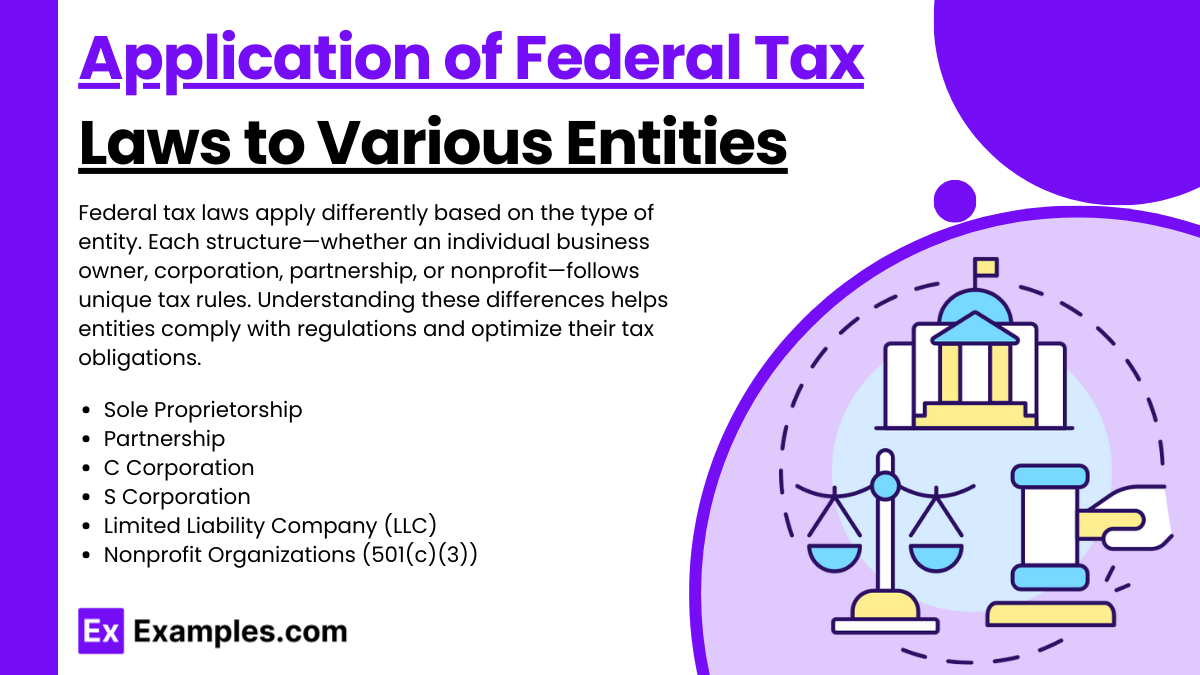
Federal tax laws apply differently based on the type of entity. Each structure—whether an individual business owner, corporation, partnership, or nonprofit—follows unique tax rules. Understanding these differences helps entities comply with regulations and optimize their tax obligations.
1. Sole Proprietorship
- Taxation: Income is reported on the owner’s personal tax return (Form 1040, Schedule C).
- Self-Employment Tax: Owners pay 15.3% for Social Security and Medicare taxes.
- Deductions: Business expenses reduce taxable income.
Example: A freelance consultant reports both income and business-related expenses on their individual tax return.
2. Partnership
- Taxation: Partnerships are pass-through entities; income is reported on partners’ individual returns (Form 1065 and Schedule K-1).
- Self-Employment Tax: Partners typically pay self-employment tax on their share of profits.
- Profit Sharing: Income is divided based on the partnership agreement.
Example: A law firm partnership distributes profits to partners, who report it as personal income.
3. C Corporation
- Taxation: C corporations are taxed separately from owners at the corporate tax rate (21%).
- Double Taxation: Profits are taxed at the corporate level and again as dividends when distributed to shareholders.
- Deductions: Corporations can deduct business expenses and employee wages.
Example: A retail corporation earns $1 million in profit, paying corporate tax on it, and shareholders are taxed again on dividends received.
4. S Corporation
- Taxation: S corporations are pass-through entities; income flows to shareholders and is taxed on their personal returns (Form 1120-S and Schedule K-1).
- Self-Employment Tax: Shareholders pay employment taxes only on salaries, not distributions.
- Eligibility: Limited to 100 shareholders and only certain types of individuals or trusts.
Example: A small business owner receives both a salary and profit distributions, with only the salary subject to employment taxes.
5. Limited Liability Company (LLC)
- Taxation: LLCs can choose to be taxed as a sole proprietorship, partnership, or corporation.
- Pass-Through Taxation: By default, LLCs are taxed as pass-through entities (like partnerships).
- Flexibility: LLC members report their share of profits and pay self-employment tax.
Example: An LLC with two members files a partnership return, and each member reports their share of profits on individual tax returns.
6. Nonprofit Organizations (501(c)(3))
- Tax Exemption: Income related to the nonprofit’s purpose is tax-exempt.
- Unrelated Business Income (UBI): Nonprofits pay tax on unrelated income using corporate tax rules (Form 990-T).
- Donor Deductions: Contributions to nonprofits are tax-deductible for donors.
Example: A charity selling donated books for profit must report unrelated income but pays no tax on donations supporting its mission.
Formation, Operation, and Liquidation of Entities
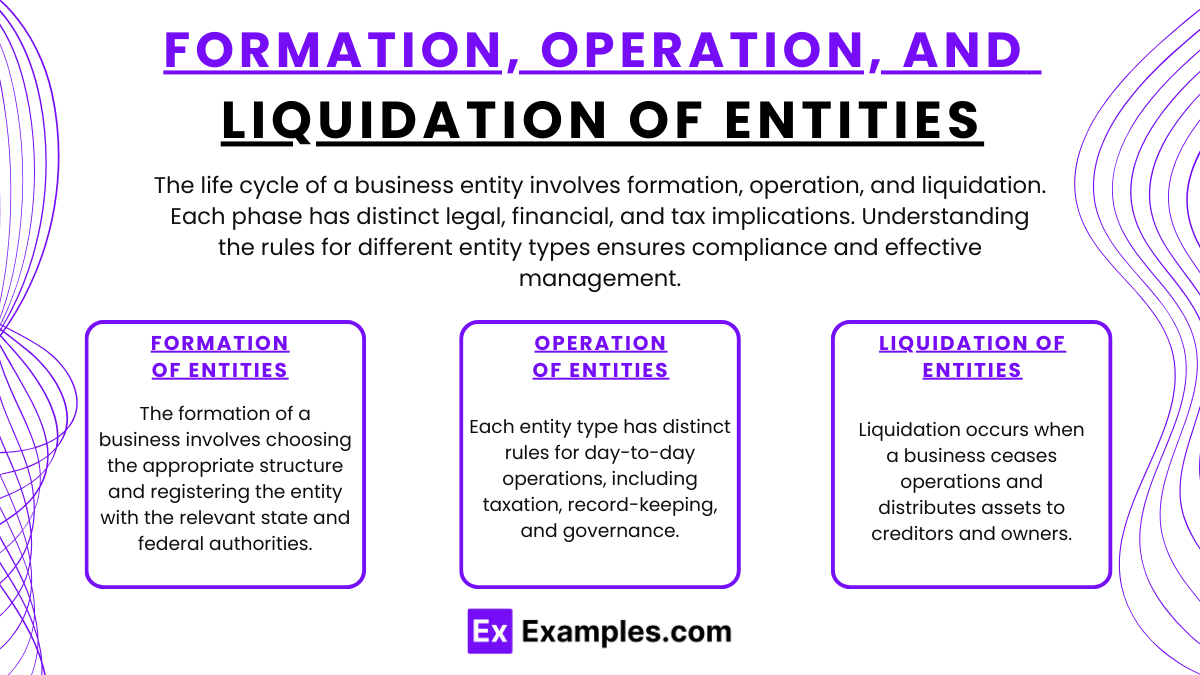
The life cycle of a business entity involves formation, operation, and liquidation. Each phase has distinct legal, financial, and tax implications. Understanding the rules for different entity types ensures compliance and effective management.
1. Formation of Entities
The formation of a business involves choosing the appropriate structure and registering the entity with the relevant state and federal authorities.
Key Steps in Formation:
- Business Structure Selection: Sole proprietorship, partnership, corporation, LLC, or nonprofit.
- Registration with the State: Filing formation documents such as Articles of Incorporation (for corporations) or Articles of Organization (for LLCs).
- Obtaining an EIN: Most entities require an Employer Identification Number (EIN) from the IRS.
- Operating Agreements or Bylaws: Partnerships, LLCs, and corporations often draft these documents to outline ownership and governance.
Example: A business owner forms an LLC by filing Articles of Organization with the state and setting up an operating agreement with other members.
2. Operation of Entities
Each entity type has distinct rules for day-to-day operations, including taxation, record-keeping, and governance.
Operation for Different Entities:
- Sole Proprietorship: Simple structure; the owner manages all operations and reports business income on Schedule C of their personal tax return.
- Partnership: Partners share profits and losses as outlined in the partnership agreement; income is passed through to partners and reported on Schedule K-1.
- C Corporation: Managed by a board of directors and officers; income is taxed at the corporate level and dividends are taxed again when distributed.
- S Corporation: Income passes through to shareholders; shareholders pay employment taxes on salaries but not on distributions.
- LLC: Members manage or appoint managers; income passes through by default but can elect to be taxed as a corporation.
- Nonprofit Organization: Operates for charitable or social purposes; must comply with rules for 501(c)(3) status to maintain tax-exempt status.
Example: A C corporation must hold annual shareholder meetings and report profits on Form 1120.
3. Liquidation of Entities
Liquidation occurs when a business ceases operations and distributes assets to creditors and owners.
Steps in Liquidation:
- Pay Off Debts: Creditors are paid before any assets are distributed to owners.
- Sell Assets: Liquidate inventory, property, and equipment.
- Distribute Remaining Assets: Distribute remaining assets to owners or shareholders.
- File Final Tax Returns: Entities must file final federal and state tax returns.
- Corporations: File Form 966 and mark final returns on Form 1120.
- LLCs and Partnerships: Report final activities on Form 1065.
- Dissolve with the State: File dissolution forms to officially close the business with state authorities.
Income, Deductions, Credits, and Tax Liabilities for Different Entities
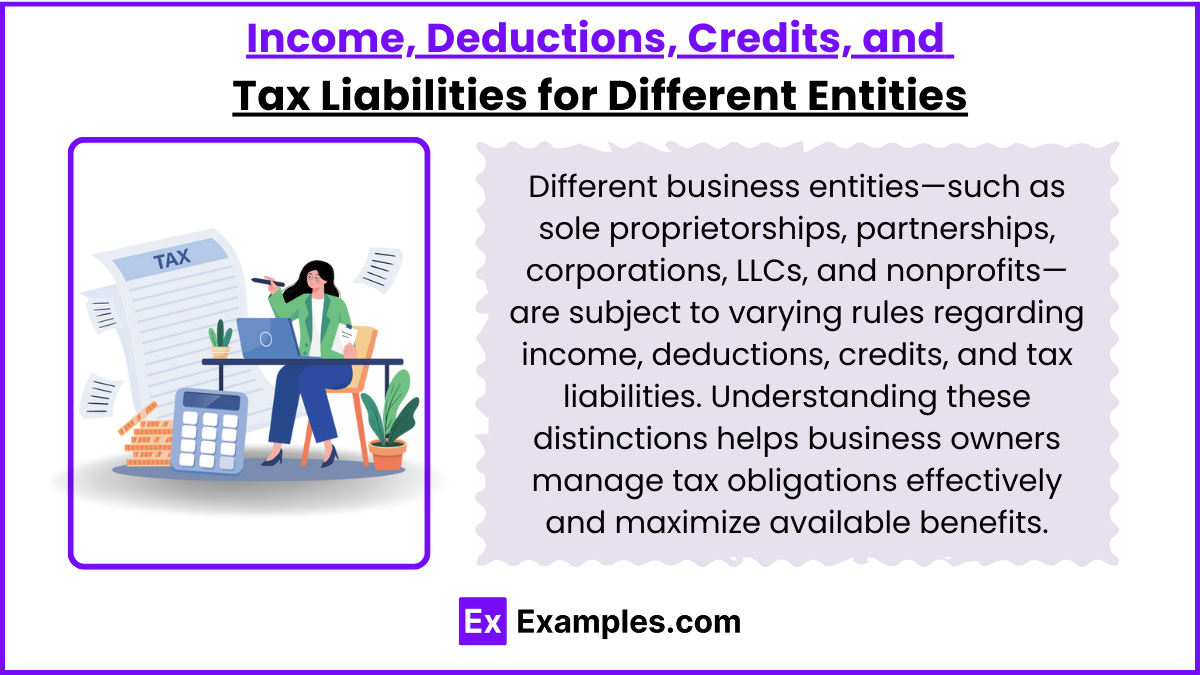
Different business entities—such as sole proprietorships, partnerships, corporations, LLCs, and nonprofits—are subject to varying rules regarding income, deductions, credits, and tax liabilities. Understanding these distinctions helps business owners manage tax obligations effectively and maximize available benefits.
Sole Proprietorship
- Income: Reported on Schedule C of the owner’s personal tax return.
- Deductions: Business expenses like rent, supplies, and travel reduce taxable income.
- Credits: May qualify for Self-Employed Health Insurance Credit and Earned Income Credit.
- Tax Liability: Profits are subject to income tax and self-employment tax (Social Security and Medicare).
Example: A sole proprietor with $100,000 in income and $20,000 in deductions pays tax on $80,000.
Partnership
- Income: Passes through to partners based on the partnership agreement and reported on each partner’s personal return (Form 1065 and Schedule K-1).
- Deductions: Business expenses and guaranteed payments to partners.
- Credits: May qualify for Work Opportunity Tax Credit and other business credits.
- Tax Liability: Each partner pays income tax and self-employment tax on their share of profits.
Example: A partnership earns $200,000, split equally between two partners. Each partner reports $100,000 on their personal return.
C Corporation
- Income: Taxed at the corporate level (21% flat rate).
- Deductions: Salaries, benefits, rent, and depreciation.
- Credits: Eligible for Research and Development Credit and Energy Tax Credits.
- Tax Liability: Double taxation occurs—once at the corporate level and again when dividends are distributed to shareholders.
Example: A C corporation with $1 million in income and $300,000 in deductions pays corporate tax on $700,000.
Limited Liability Company (LLC)
- Income: By default, treated as a pass-through entity; can elect to be taxed as a corporation.
- Deductions: Operating expenses, depreciation, and Section 179 deductions.
- Credits: May qualify for small business credits such as the Work Opportunity Credit.
- Tax Liability: Members pay income and self-employment taxes on their share of profits unless the LLC elects corporate taxation.
Example: An LLC with $300,000 in profits distributes the income equally among three members, who each report $100,000.
Pass-Through Entities vs. Corporations
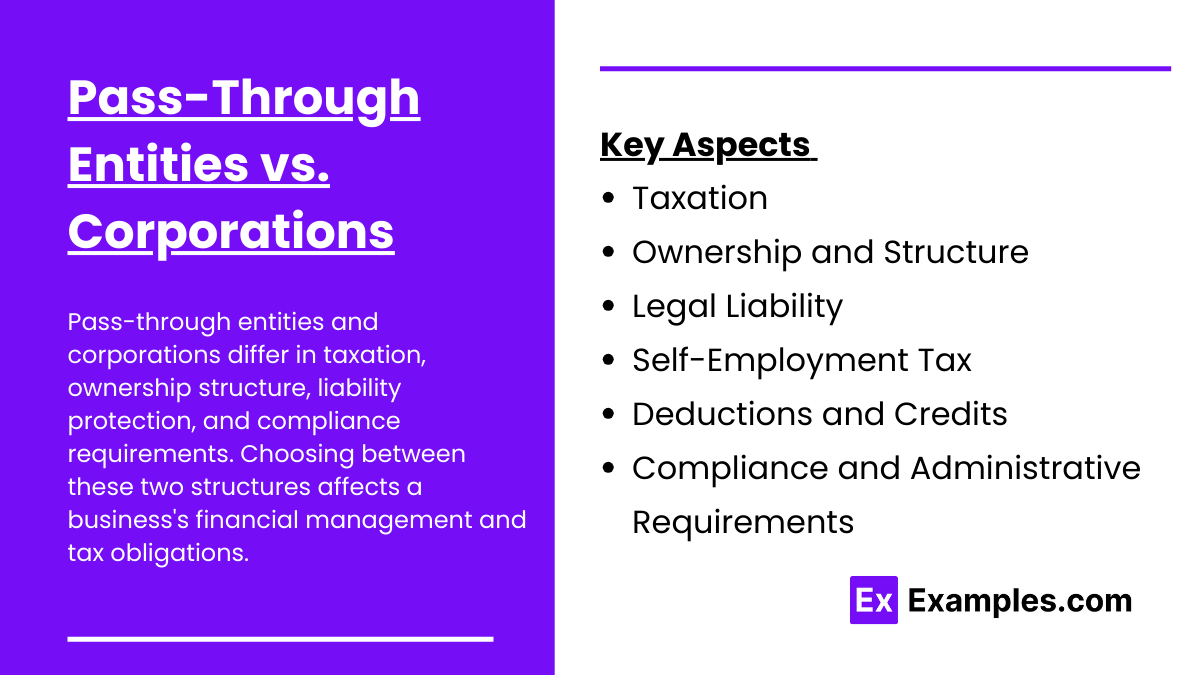
Pass-through entities and corporations differ in taxation, ownership structure, liability protection, and compliance requirements. Choosing between these two structures affects a business’s financial management and tax obligations.
1. Taxation
- Pass-Through Entities:
- Income “passes through” to the owners’ personal tax returns, avoiding double taxation.
- Examples: Sole proprietorships, partnerships, LLCs, and S corporations.
- Corporations (C Corporations):
- Subject to double taxation: the corporation pays taxes on profits (21%), and shareholders pay taxes on dividends.
- S corporations avoid double taxation by passing income to shareholders but must meet specific eligibility rules.
2. Ownership and Structure
- Pass-Through Entities:
- Flexible ownership; S corporations are limited to 100 shareholders (individuals, estates, or trusts).
- Partnerships and LLCs can divide profits however they agree, regardless of ownership percentage.
- Corporations (C Corporations):
- Can have unlimited shareholders, including other corporations or foreign investors.
- Ownership is divided through stocks, facilitating fundraising and attracting investors.
3. Legal Liability
- Pass-Through Entities:
- LLCs and S corporations offer limited liability protection for owners.
- Sole proprietors and general partners have unlimited personal liability for business debts.
- Corporations:
- Shareholders’ personal assets are protected from business liabilities, except in cases of fraud or negligence.
4. Self-Employment Tax
- Pass-Through Entities:
- Owners (except S corp shareholders) pay self-employment tax on all business profits (15.3%).
- S corp shareholders pay self-employment tax only on their salaries, not on profit distributions.
- Corporations:
- Shareholders working for the company receive salaries subject to employment taxes, but dividends are not subject to these taxes.
5. Deductions and Credits
- Pass-Through Entities:
- Eligible for the Qualified Business Income (QBI) deduction, offering up to 20% deduction on business income.
- May have fewer business tax credits compared to corporations.
- Corporations:
- Access to more tax deductions and credits, such as fringe benefits and R&D credits.
- C corporations can deduct employee benefits like health insurance and retirement plans.
6. Compliance and Administrative Requirements
- Pass-Through Entities:
- Easier to manage with minimal filing and reporting requirements.
- LLCs and partnerships allow flexibility in profit distribution without strict governance rules.
- Corporations:
- Must comply with strict governance requirements, including annual meetings, bylaws, and formal record-keeping.
- C corporations require more paperwork and regulatory compliance than LLCs or S corporations.
Examples
Example 1: Sale of Real Estate
When an individual sells real estate, such as a home or rental property, the transaction may result in capital gains or losses. If the property is sold for more than its purchase price (adjusted basis), the seller may owe capital gains tax on the profit. Understanding the rules for primary residence exclusion and investment property taxation is crucial for accurate reporting and tax planning.
Example 2: 1031 Like-Kind Exchange
A 1031 exchange allows investors to defer capital gains taxes on the sale of an investment property by reinvesting the proceeds into a similar property. This transaction must meet specific requirements, such as identifying a replacement property within a certain timeframe. This provision encourages investment in real estate while postponing immediate tax liabilities, making it a popular strategy among real estate investors.
Example 3: Inheritance of Property
When individuals inherit property, such as real estate or stocks, they receive a step-up in basis. This means that the property is valued at its fair market value at the date of the decedent’s death rather than the original purchase price. If the heir sells the inherited property, they may only pay capital gains tax on the appreciation that occurs after the inheritance, which can significantly reduce tax liability.
Example 4: Property Depreciation
For rental properties and business assets, depreciation allows property owners to deduct the cost of the property over its useful life from their taxable income. This non-cash deduction helps reduce taxable income, reflecting the property’s wear and tear. Understanding how to calculate and apply depreciation is essential for property owners to maximize their tax benefits and ensure compliance with IRS regulations.
Example 5: Capital Gains Tax on Investment Property
When an individual sells an investment property, the profit generated is typically subject to capital gains tax. This includes short-term capital gains (for properties held for one year or less) and long-term capital gains (for properties held for more than one year), which are taxed at different rates. Understanding the implications of capital gains tax on property transactions is critical for investors and property owners when making decisions about selling or holding their investments.
Practice Questions
Question 1
Which of the following entities is typically subject to double taxation under federal tax law?
A) Sole proprietorship
B) Limited liability company (LLC)
C) S corporation
D) C corporation
Correct Answer: D) C corporation.
Explanation: A C corporation is a separate legal entity from its owners and is subject to federal income tax at the corporate level. When profits are distributed to shareholders as dividends, they are taxed again at the individual level, resulting in double taxation. In contrast, sole proprietorships, LLCs, and S corporations typically pass their income through to the owners’ personal tax returns, avoiding double taxation.
Question 2
What is the main purpose of the IRS Form 1065?
A) To report the income of a corporation
B) To calculate the payroll taxes for employees
C) To report the income and expenses of a partnership
D) To determine the tax credits for individuals
Correct Answer: C) To report the income and expenses of a partnership.
Exphttps://www.examples.com/cpa/area-v-federal-taxation-of-entities-including-tax-preparationlanation: Form 1065 is specifically designed for partnerships to report their annual income, deductions, gains, and losses. This form allows partnerships to provide detailed financial information to the IRS, but it does not impose tax on the partnership itself. Instead, the income is passed through to the partners, who report it on their individual tax returns. Options A, B, and D pertain to other types of entities or tax situations.
Question 3
Which of the following tax forms must a C corporation file to report its income and calculate its tax liability?
A) Form 1040
B) Form 1120
C) Form 1065
D) Form 941
Correct Answer: B) Form 1120.
Explanation: Form 1120 is the tax return that C corporations must file with the IRS to report their income, gains, losses, deductions, and credits. This form is essential for calculating the corporation’s tax liability based on its taxable income. In contrast, Form 1040 is for individual taxpayers, Form 1065 is for partnerships, and Form 941 is used for reporting employment taxes. Understanding the appropriate forms for different entity types is crucial for effective tax preparation.

